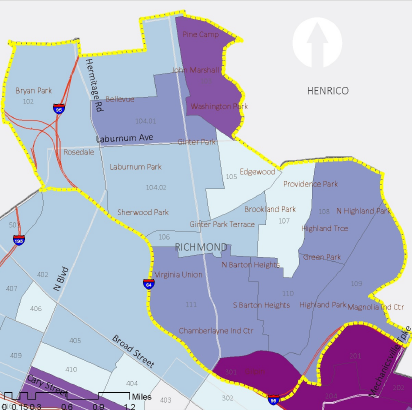News
CURA Maps Indicators of Distress for Richmond’s Northside Neighborhoods

August 1, 2018
By Brittany Keegan
The Wilder School’s Center for Urban and Regional Analysis within the Center for Public Policy recently conducted a study to map indicators of distress for Richmond’s Northside neighborhoods.
To gather data, the CURA team collected relevant socioeconomic and children’s health and education data from public sources, mapped the information, and conducted statistical comparisons between the city of Richmond and the city’s Northside. They also conducted comparisons among different neighborhoods in Northside. The analysis was conducted at the census tract level using CURA’s MetroView information and analysis system, which provides a holistic yet detailed picture of technical and social qualities of the Richmond Metropolitan Area. CURA prepared the report for the Robins Foundation and Communitas Consulting.
“We found that the Richmond Northside lags behind the rest of the city in almost all socioeconomic, health, and children-related metrics,” said Sarin Adhikari, Ph.D., CURA’s research economist.
“The indicators also vary among the Northside neighborhoods with differences that show a visible geographic divide between the western side and the eastern side. The differences seem to be strongly correlated with race and income characteristics of the neighborhoods. This level of granular analysis was possible due to CURA's MetroView database.”
Specific findings from this study included:
- Poverty and unemployment among families with children is much higher in Northside neighborhoods compared to the city of Richmond.
- Northside ZIP codes have the highest rates of low birth weight babies and higher teen birth rates than the city. Rates in the eastern part of the study area were particularly high.
- Elementary education scores are lower in Northside compared to the city. Schools located on the eastern part of Northside are among the lowest performing schools in Richmond.
- Life expectancy is lower in tracts with a greater percentage of residents who identify as African American, a greater percentage of households with lower incomes, and high unemployment and poverty rates. Gilpin, Pine Camp, Washington Park and John Marshall have the lowest life expectancies in the city.
- Northside neighborhoods have more licensed childcare slots relative to the population of children under five years old than the city of Richmond. A majority of child care slots are concentrated on the west side of the study area.
By identifying these and other areas of distress, the study identifies baseline measures against which change can be measured, helping to create a path forward for Richmond’s leaders, policymakers and community members to begin addressing the needs of the Northside community.